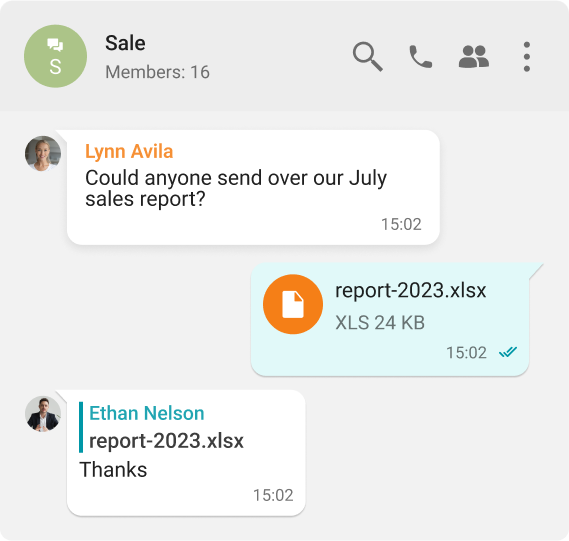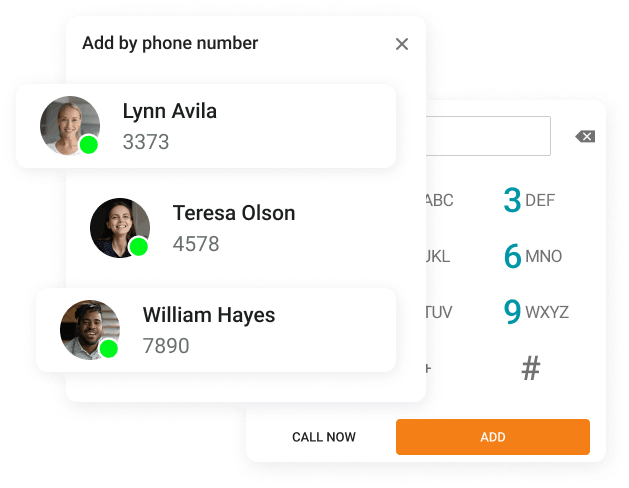Utilize the shared address book to search for not only other TrueConf Server users, but also for connected SIP/H.323 devices. Create groups of contacts by inviting all participants with just one click!
Promptly solve urgent work issues! Create personal and group chats that allow for exchanging messages not only during conferences but also outside of them.
Call and invite users of your PBX, external telephone subscribers or even VoIP devices registered on TrueConf Server to a group video conference.
Plan video meetings in advance! Set up the date, time and duration of conferences, as well as set a schedule of regular events.
Make free audio and video calls to colleagues from any compatible device, without having to worry about time constraints.
Add TrueConf video conferences to any events in Outlook and Thunderbird calendars! Use special plugins to easily schedule meetings with colleagues without distracting from the workflow.
Whether it’s a quick message to a colleague, a video call with a remote team, or a conference with clients, staying connected keeps everything moving. But when messages, calls, and meetings happen across different platforms, things get messy — missed updates, delayed responses, and scattered workflows.
Unified Communication (UC) brings everything together — messaging, calls, video meetings, and collaboration tools — all in one system. For businesses, this means faster decisions, better teamwork, and fewer communication breakdowns. When everything is in sync, projects move forward smoothly, and employees stay connected — no matter where they are.
On-Premises UC: More Control, Bigger Investment
On‑premises UC runs entirely on servers owned and managed by the company, giving businesses full control over security, data, and system updates. The in‑house IT team handles all maintenance to ensure smooth and reliable operation.
Cloud-Based UC: Flexible and Cost-Effective
Cloud-based UC is hosted by an external provider, eliminating the need for businesses to manage their own servers. It’s a cost-effective solution that scales easily as the company grows and enables employees to connect from anywhere.
Hybrid UC: The Best of Both Worlds
A hybrid setup combines on‑premises infrastructure with cloud‑based services, delivering a balance of security, flexibility, and scalability. Businesses can store sensitive data on their own servers while leveraging cloud tools for remote work and team collaboration.
On‑premises unified communications (UC) keeps everything within the company’s own infrastructure, ensuring privacy, security, and uninterrupted service.
Why Businesses Choose On‑Premises UC?
Strong Security and Compliance
When communication data is stored on-site, businesses can establish their own security policies, manage access, and implement encryption without relying on third-party providers. This decreases cybersecurity risks and helps industries such as finance, healthcare, and government comply with rigorous regulatory standards.
Reliable Communication: No Internet Required
Since on‑premises UC operates within a company’s internal network, calls, video conferences, and messaging continue functioning even if the internet connection fails. For businesses that depend on uninterrupted, high-quality communication, this reliability is a critical advantage.
Adaptable to Business Needs
Unlike cloud-based systems with fixed functionalities, on-premises UC allows businesses to tailor their setup to specific requirements. They can integrate UC with existing software, support systems, and industry-specific applications to optimize workflow efficiency.
Long-Term Cost Efficiency
Although initial implementation of on-premises UC incurs higher costs, eliminating recurring cloud subscription fees leads to savings over time. Businesses with established IT infrastructure benefit from reduced operating expenses while retaining full control over their communication ecosystem.
Maintenance and Updates on Your Terms
Cloud-based platforms update according to the provider’s schedule, which may occasionally disrupt operations. With on-premises UC, organizations decide when to deploy updates, ensuring seamless transitions and compatibility with internal systems.
AI Assistance
Artificial intelligence now assists businesses by drafting emails, summarizing meetings, and automating routine tasks — saving time and boosting productivity.
Hybrid Work Support
Employees can work seamlessly from home, the office, or on the go, using tools designed to support flexibility and collaboration from anywhere.
Better Integrations
Open APIs allow meeting solutions to connect with calendars, CRM systems, and productivity apps, streamlining workflows.
Smarter Meeting Spaces
AI-powered cameras, spatial audio, and digital whiteboards make meetings more engaging. These features ensure all participants — whether in the office or remote — stay involved.
Stronger Security
As data privacy regulations tighten, meeting platforms are doubling down on security. Features such as configurable data retention policies, audit trails, and enhanced access controls help businesses protect sensitive information.
Immersive Collaboration
Extended Reality (XR) is transforming virtual meetings. Through spatial computing and 3D environments, teams can collaborate in a way that feels more natural and immersive — bringing virtual interactions closer to real-life experiences.
When choosing a unified communications solution, businesses must decide between cloud UC and on‑premises UC. Both deliver powerful communication capabilities, yet differ notably in deployment, management, cost, and flexibility. Below is a detailed comparison to guide your decision:
Feature | Cloud UC (UCaaS) | On-Premises UC |
|---|---|---|
Deployment | Hosted and managed by a third-party provider via the internet — no in-house hardware needed. | Installed and maintained on the organization’s own servers. |
Cost | Lower upfront costs, subscription-based model with no hardware or extensive IT maintenance costs. | High initial investment for hardware, software, and dedicated IT staff. |
Scalability | Easily scalable — add or remove users quickly without additional infrastructure. | Scaling requires extra hardware and IT resources, increasing time and cost. |
Accessibility | Accessible from any internet-connected device: office, remote, or mobile. | Limited to locations with access to the internal network. |
Maintenance & Updates | Automatic updates and maintenance handled by the provider. | Requires in-house IT staff for updates, maintenance, and troubleshooting. |
Security | Data stored off-site with encryption, though cloud security concerns may remain. | Full control over security with data stored on premises for direct oversight. |
Customization | Customization limited by the provider’s platform. | Greater customization tailored to specific business needs and integrations. |
Internet Dependence | Fully dependent on a stable internet connection for service access. | Operates independently of the internet — relying solely on the local network. |
Disaster Recovery | Built-in disaster recovery and backup capabilities provided by the provider. | Requires in-house infrastructure for backup and disaster recovery mechanisms. |
Businesses and organizations rely on seamless communication to stay competitive, deliver superior services, and maintain smooth operations.
Corporate Sector: Smoother Teamwork, Faster Decisions
In today’s fast‑paced business environment, teams must communicate clearly and act swiftly. UC tools consolidate messaging, video conferencing, and project collaboration into a single platform, ensuring employees can connect effortlessly — whether they’re in the office or working remotely.
Healthcare: Connecting Medical Professionals and Patients
Whether it’s a doctor consulting with a distant specialist, a nurse updating patient records, or a virtual physician‑patient appointment — UC ensures these interactions happen seamlessly. Telemedicine thrives on real‑time video and secure messaging, facilitating the safe and efficient sharing of critical healthcare information.
Education: Bridging Gaps in Learning
UC extends the classroom beyond its physical boundaries. Teachers deliver lessons through virtual classrooms, students collaborate in groups, and universities host webinars reaching learners globally. Whether in person or remotely, education remains uninterrupted and interactive.
Finance: Secure and Instant Communication
Speed and security are paramount in the financial sector. UC allows advisors, analysts, and clients to communicate instantly while adhering to stringent compliance standards. Secure video meetings, encrypted messaging, and document-sharing tools help keep sensitive financial data protected.
Manufacturing & Logistics: Streamlining Operations
Coordinating production lines, tracking shipments, and managing the supply chain require real-time communication. UC helps factories and warehouses remain synchronized by enabling instant updates, reducing downtime, and ensuring efficient operations.
Government & Public Sector: Strengthening Public Services
Government agencies use UC to enhance interdepartmental communication, simplifying coordination of initiatives, emergency response management, and digital public service delivery. Remote collaboration tools also ensure government employees remain connected, even when working from different locations.
Legal Services: Secure and Efficient Client Communication
Law firms employ UC for confidential virtual meetings, collaborative document handling, and private client communication. Secure messaging and encrypted video calls ensure sensitive legal matters remain protected while enabling attorneys to work effectively from any location.
TrueConf
TrueConf provides a comprehensive unified communications solution tailored to enhance collaboration and communication within organizations. Below is an overview of TrueConf’s key offerings based on essential comparison factors: Core features: TrueConf delivers high-definition video conferencing (up to 4K), VoIP, instant messaging for individuals and groups, presence indicators, and secure file sharing. It also includes AI-driven features such as real-time transcription, virtual backgrounds, noise suppression, and simultaneous interpretation.
APIs and SDKs: Developers can leverage TrueConf’s APIs and SDKs to build custom integrations and automate workflows, aligning the platform with specific organizational needs.
Deployment models: TrueConf supports flexible deployment options, including on-premises, cloud-based, and hybrid models, allowing organizations to choose the setup that best matches their infrastructure and security requirements.
User scalability: the platform accommodates businesses of all sizes, supporting meetings with up to 1,500 participants while maintaining seamless performance.
Regulatory compliance: TrueConf complies with GDPR, HIPAA, and ISO 27001 standards, making it suitable for industries with strict data protection requirements.
Cross-Device Compatibility: сlient applications are available for Windows, macOS, Linux, iOS, Android, and Android TV, enabling connectivity across a wide range of devices.
8x8
8x8 offers an all-in-one unified communications solution designed to enhance collaboration across organizations:
Core Features: the 8x8 Work app integrates business phone services, video conferencing, and team messaging. It also includes AI-powered features like speech analytics and quality management to improve communication effectiveness. APIs are available for SMS, voice, video, and chat integration within existing workflows.
APIs and SDKs: developers can use 8x8’s APIs to embed communication tools such as SMS, voice, and video into custom applications.
Deployment models: 8x8 is a fully cloud-hosted solution that removes the need for on-premises hardware, offering scalability and flexibility.
User scalability: the platform accommodates needs from small teams to large enterprises, ensuring consistent performance at scale.
Regulatory compliance: 8x8 meets industry standards, including HIPAA, GDPR, and ISO/IEC 27001, making it suitable for regulated environments.
Cross-Device Compatibility: accessible via desktop, mobile, web, and browser platforms, providing versatile access without extra software.
Avaya
Avaya delivers a unified communications solution to enhance collaboration across organizations:
Core Features: Avaya integrates voice, video, messaging, and web collaboration. AI elements, including virtual assistants and predictive analytics, support customer engagement and operational efficiency.
APIs and SDKs: developers can use Avaya’s APIs and SDKs to build integrations with custom business applications.
Deployment models: available as on-premises (Avaya Aura), cloud-based (Avaya Cloud Office), and hybrid options, tailored to infrastructure and security needs.
User scalability: supports businesses of all sizes and scales to enterprise environments with up to 250,000 users.
Regulatory compliance: aligns with international standards, suitable for industries with strict compliance demands.
Cross-Device Compatibility: supports desktops, smartphones, and tablets, preserving user connectivity across devices.
Cisco
Cisco’s unified communications solution enhances collaboration and simplifies interaction:
Core Features: Includes voice, video, messaging, and mobility, anchored by Cisco Unified Communications Manager (UCM) for secure call management. Supports HD video, instant messaging, presence, and integration with collaboration tools, optimized for both on-site and remote users.
APIs and SDKs: offers comprehensive APIs and SDKs for building custom UC extensions tailored to business needs.
Deployment models: available on-premises (Cisco UCM), cloud-based (Cisco UCM Cloud), or hybrid, enabling flexible selection based on infrastructure strategy.
User scalability: scales from 50,000 devices in a standard cluster up to 100,000 in a mega cluster.
Regulatory compliance: meets industry-specific standards, and Cisco UCM Cloud for Government is FedRAMP compliant.
Cross-Device Compatibility: covers desktops, smartphones, tablets, and IP phones — ensuring seamless user connectivity.
Microsoft Teams
Microsoft Teams is a comprehensive UC platform combining communication and collaboration tools:
Core Features: offers chat, video meetings, and file sharing integrated with Microsoft 365. Includes AI-driven assistance via Microsoft 365 Copilot for meeting summaries, data insights, and task automation.
APIs and SDKs: provides developer APIs and SDKs to extend and customize Teams functionalities.
Deployment models: fully cloud-based, offering scalability and flexibility without on-premises hardware.
User scalability: designed for organizations of all sizes, maintaining performance as the user base grows.
Regulatory compliance: meets GDPR and HIPAA compliance for secure data handling.
Cross-Device Compatibility: Available on desktops, laptops, tablets, and smartphones.
Mitel
Mitel provides a unified communications solution for businesses of all sizes:
Core Features: MiVoice Business delivers voice, messaging, mobility, conferencing, voicemail transcription, call recording, and video collaboration. It integrates with major CRM systems for enhanced workflows.
APIs and SDKs: Developers can use Mitel APIs for custom integrations into business applications.
Deployment models: Supports on-premises, cloud-based, and hybrid deployments, including public and private cloud options.
User scalability: Scalable to support growing organizations without performance loss.
Regulatory compliance: Built to meet international standards for regulated industries.
Cross-Device Compatibility: Offers seamless connectivity across desktops, mobile phones, and tablets.
RingCentral
RingCentral delivers a unified communications platform designed for integrated business collaboration:
Core Features: RingCentral integrates calls, messaging, video meetings, and fax (RingEX™). Includes AI Assistant for call transcriptions, summaries, and action items, plus automated SMS replies and voicemail-to-email transcription.
APIs and SDKs: Open platform APIs cover voice, SMS/MMS, messaging, video, fax, data, and configuration — enabling tailored integrations.
Deployment models: fully cloud-based — no on-premises hardware required, offering scalability and flexibility.
User scalability: Supports organizations of any size with seamless performance during growth.
Regulatory compliance: complies with HITRUST, GDPR, PCI, and HIPAA standards.
Cross-Device Compatibility: accessible on desktops, smartphones, and tablets with consistent UX.
Unify
Unify (a Mitel subsidiary since October 2023) is a global provider of enterprise communications, delivering solutions in over 100 countries:
Core Features: Includes OpenScape (voice, video, web collaboration, contact center), HiPath (secure and scalable converged communication), and Circuit (cloud-based team collaboration). SIP architecture ensures interoperability through presence, unified messaging, and mobility support.
APIs and SDKs: Offers APIs/SDKs for custom integrations tailored to operational needs.
Deployment models: Flexible deployment, including on-premises (OpenScape, HiPath), cloud (Circuit), or hybrid.
User scalability: Scales to support organizations from small businesses to large enterprises.
Regulatory compliance: Adheres to international standards, suitable for regulated industries.
Cross-Device Compatibility: Available on desktops, laptops, tablets, and smartphones.
Zoom
Zoom Communications provides a UCaaS platform to optimize business communication:
Core Features: Integrates video conferencing, VoIP services, team chat, and webinars in one app. Features AI Companion for real-time transcription, summaries, and action tracking; includes voicemail transcription, intelligent call routing, and integration with productivity tools.
APIs and SDKs: Robust APIs/SDKs allow embedding Zoom into custom applications.
Deployment models: Entirely cloud-based — scales quickly, no on-premises infrastructure needed.
User scalability: Scalable infrastructure serves small teams up to large enterprises with consistent performance.
Regulatory compliance: Designed to support compliance with international data protection standards.
Cross-Device Compatibility: Available on desktops, laptops, tablets, and smartphones.
As businesses adopt unified communications (UC), they face increasing security risks. Cybercriminals target these systems to steal data, gain unauthorized access, or disrupt operations. Protecting UC platforms is essential for securing business communication.
Increased Risks with UCaaS & BYOD
Many organizations now use UCaaS and allow employees to work from personal devices (BYOD). While this facilitates collaboration, it also amplifies security risks. With UCaaS, organizations depend in part on third-party providers’ security measures. BYOD introduces sensitive corporate data across multiple personal devices, complicating access control and threat prevention (such as malware, phishing, and unauthorized access).
API Vulnerabilities & Credential Theft
Open APIs are widely used to integrate UC tools and streamline workflows. However, poorly secured APIs can become attack vectors. Cybercriminals may exploit weak authentication, stolen credentials, or unpatched APIs to penetrate systems, manipulate data, or disrupt communications.





